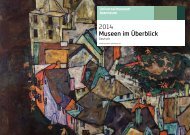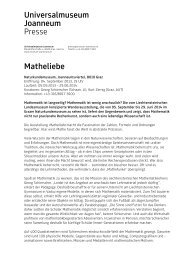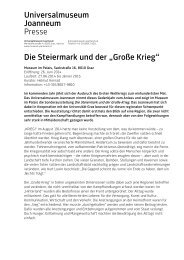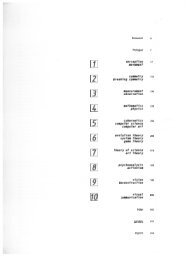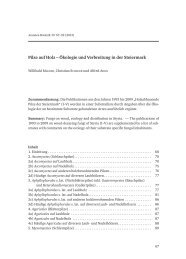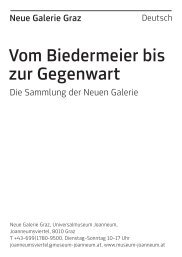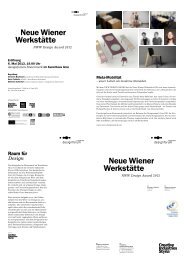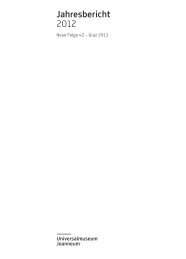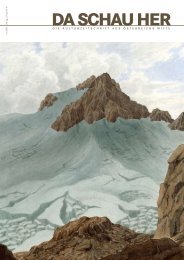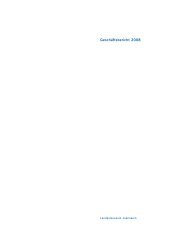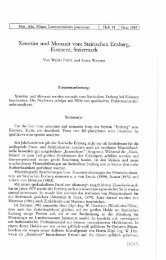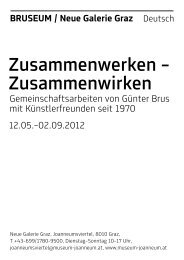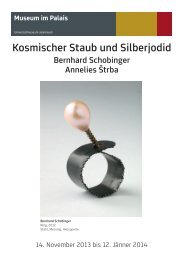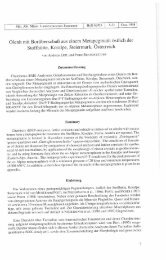Human Condition - Universalmuseum Joanneum
Human Condition - Universalmuseum Joanneum
Human Condition - Universalmuseum Joanneum
Sie wollen auch ein ePaper? Erhöhen Sie die Reichweite Ihrer Titel.
YUMPU macht aus Druck-PDFs automatisch weboptimierte ePaper, die Google liebt.
60 Mark Manders, in The Absence<br />
of Mark Manders, Kunstverein<br />
Hannover, Bergen Kunsthall,<br />
S.M.A.K. Ghent, Kunsthaus Zürich,<br />
(Ostfildern: Hatje Cantz 2007),<br />
p. 53.<br />
61 Ibid., p. 22.<br />
62 Ibid., p. 120.<br />
recessed displays in natural history museums, Dzama’s dioramas are showcases for<br />
Dantesque and Kafkaquese rituals of social ordeal. Dzama’s Pip (2004) is yet another<br />
assemblage, composed of the grotesque figure of a (human) animal, dressed in an elegant<br />
if not pedantic suit of felt and fake fur, wire mash, paper maché, plastic foam and<br />
rubber, and accompanied by drawings and watercolours that apparently represent the<br />
hero’s (bureaucratic) credo (including messages such as “we will disappear” or “lost in<br />
endless time,”, as well as Pip’s biography). Here too, we are in the realm of burlesque,<br />
or on the stage of a marionette theatre, which evokes the memory of high school<br />
performances based upon the haunted house experience of an uneasy, traumatic childhood.<br />
Simultaneously strange and familiar, Dzama’s imagery depicts the world upside<br />
down, on the constant desperate search for its own renewal and recovery. His hyperlong<br />
drawing in three sections, Ulysses, (2009) as well as series of collages (2008-<br />
2009) are diaries of civilization, inhabited by infamous ghosts of former eras and<br />
shadow-like characters from old silent movies, engaged in the perverse practices of<br />
violence and pornography. This neodadaist theatrics of acute anxiety is the dehumanized<br />
world of today – tormented by wars and terrors, suffering of moral decay and ethical<br />
collapse. Dzama’s anti-glamorous heroes: male or female warriors, overexposing<br />
their white weapons or self-made guns, commedia dell’arte-like victims of atrocities<br />
and cruelties with their mutilated or dismembered bodies and injured psychos, hopeless<br />
terrorists and impotent opressors, always inhabiting the in-between of animal<br />
and human worlds - are ridiculous and miserable actors of performance of power which<br />
turns into spectacle of horror. In his devastating, perhaps too cynical, investigations of<br />
contemporary evil, Dzama orchestrates a storyboard of society’s failure to empathise.<br />
He depicts the precarious world of interrupted intimacy and violated innocence. Values<br />
are cancelled, virtues are invalid and the sacred is absent. But – no fear! We are in the<br />
pleasure dome of an adult dreamscape. Wake up!<br />
The sculptural and installative work of the Dutch artist, Mark Manders is an anatomy<br />
of self and a pursuit of the absence of the artist who defines himself as follows: “The<br />
artist Mark Manders is a fictional person. He is a character who lives in a logically<br />
designed and constructed world, which consists of thoughts that are congealed at<br />
their moment of greatest intensity. It is someone who disappears into his actions. He<br />
lives in a building that he continually abandons; the building is uninhabited, in fact.”60<br />
As the poetic self-portrait of an individual, torn by a desire to belong and an urge to<br />
escape the confines of communal idioms and a landscape of an inner world, Manders’<br />
poignant oeuvre reflects humanity in a state of profound fragmentation, on the<br />
threshold of a possible and necessary new beginning. A séance of psychotic catharsis,<br />
it carries the promise of a rejuvenated subject, freed of the cocoon of social routine,<br />
constructing its corporeal and mental architecture as a “monument in ruins” and a<br />
lament over civilization’s collapse. “After all, what am I? A human being who unfolds<br />
into a horrifying amount of language and material by means of very precise conceptual<br />
constructions,”61 confesses the author of Self-portrait as a Building an on-going conceptual<br />
project, a sort of manifesto of a life-time, conducted by Manders since 1986,<br />
initialy planned as an oeuvre of literature, eventually focused on the spatial unfolding<br />
of the artist’s psychological self. Obsessively pursued as the investigation of a thought<br />
and the process of thinking, it develops an idea of selfhood as an architecture and<br />
a composition in space. The building is the prototype of the self in process, a living<br />
organism, a laborartory of identity production: “The building is like a gigantic set<br />
frozen in time with lots of rooms that all seem as if they have just been abandoned<br />
(…) Like an encyclopedia, the building is always ready, even though it keeps on changing<br />
and growing or shrinking.”62 Andrea Wiarda identifies Manders’ Self-portrait as a<br />
Building as “the mythical container of his attempt to understand his position in the



